Case Study: Financial Auditing of Double Ink Printers Limited (DIPL)
VerifiedAdded on 2020/06/06
|5
|1055
|42
Case Study
AI Summary
This case study examines the financial auditing of Double Ink Printers Limited (DIPL). The analysis focuses on preliminary analytical procedures, identifying malpractices in accounts receivables and depreciation expenses. The auditor identifies inherent risks related to fair value determination and interest rates, which lead to material misstatements affecting financial institutions and investors. The study highlights fraud risk factors, including issues with financial statement valuation and depreciation assessment. The auditor's approach involves scrutinizing financial notes, board discussions, and comparing asset lifespans to uncover discrepancies. The case study emphasizes the impact of these fraudulent practices on audit planning and the importance of effective risk assessment in financial auditing.
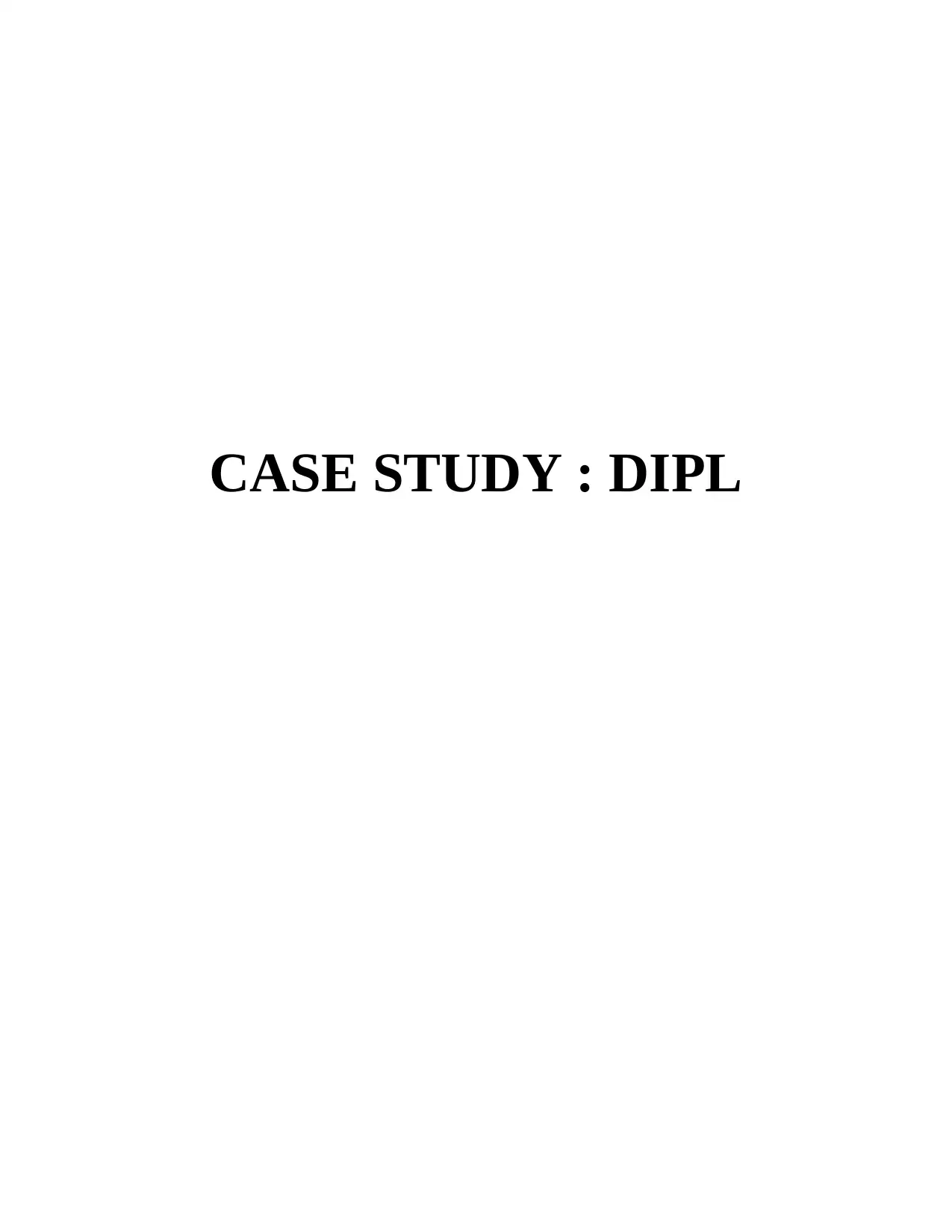
CASE STUDY : DIPL
Paraphrase This Document
Need a fresh take? Get an instant paraphrase of this document with our AI Paraphraser
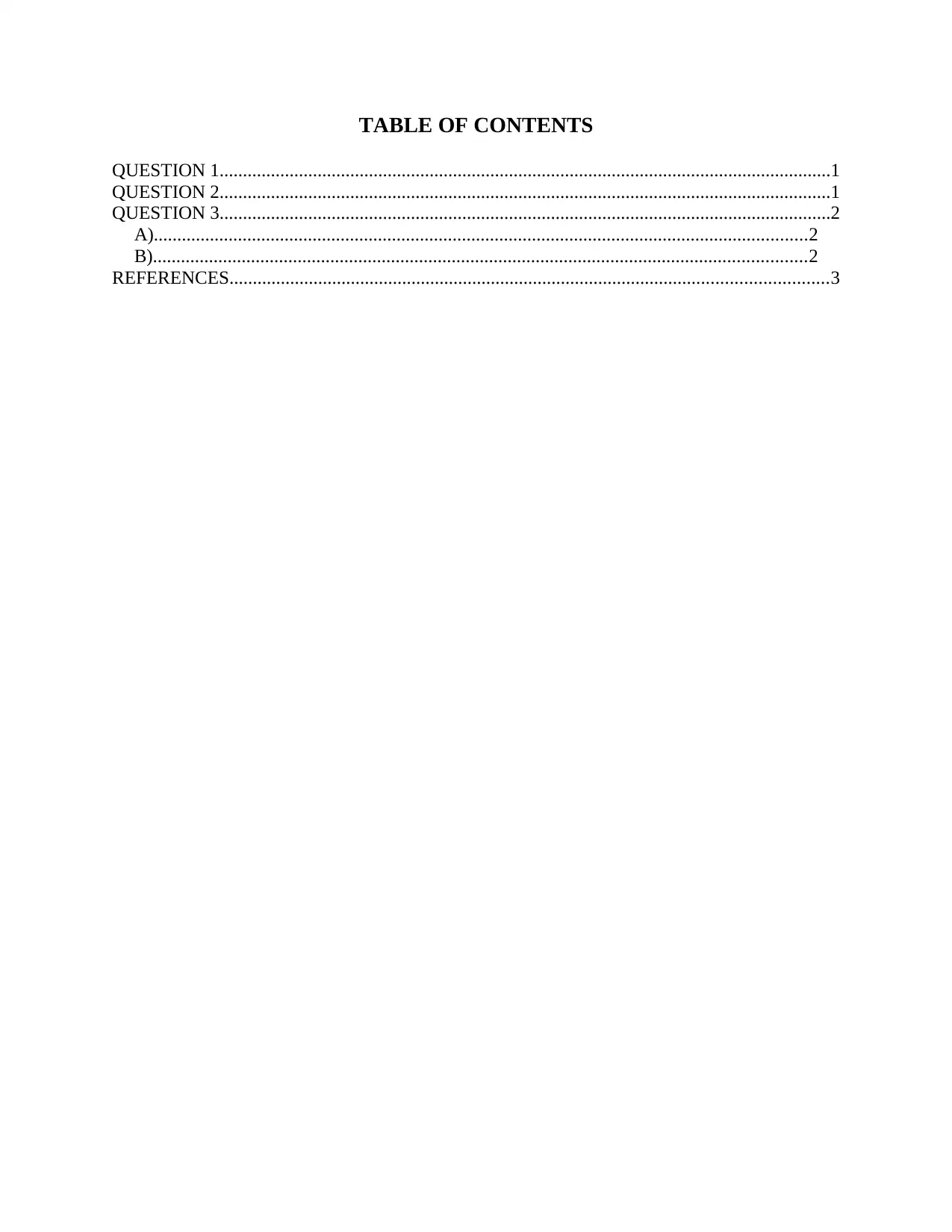
TABLE OF CONTENTS
QUESTION 1...................................................................................................................................1
QUESTION 2...................................................................................................................................1
QUESTION 3...................................................................................................................................2
A)............................................................................................................................................2
B)............................................................................................................................................2
REFERENCES................................................................................................................................3
QUESTION 1...................................................................................................................................1
QUESTION 2...................................................................................................................................1
QUESTION 3...................................................................................................................................2
A)............................................................................................................................................2
B)............................................................................................................................................2
REFERENCES................................................................................................................................3
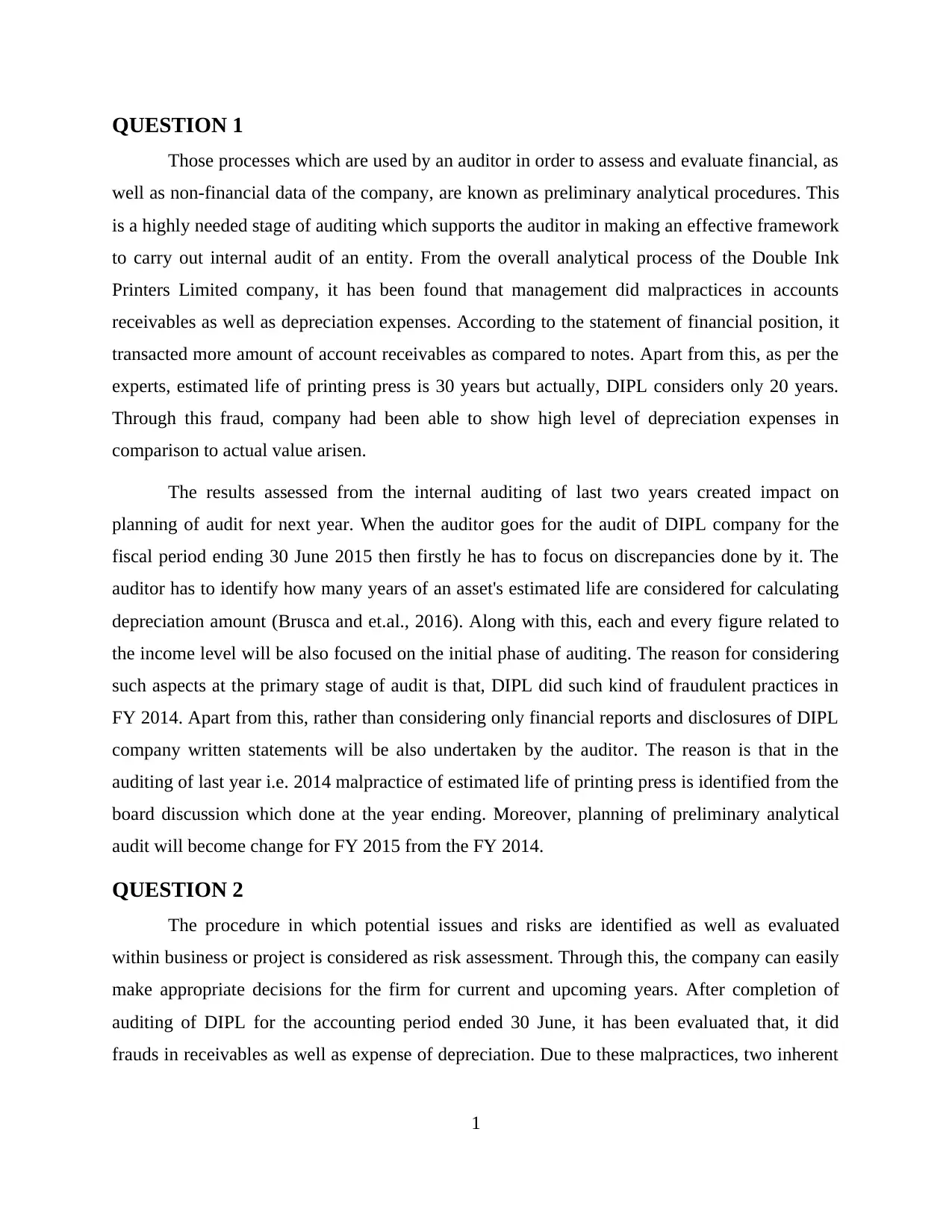
QUESTION 1
Those processes which are used by an auditor in order to assess and evaluate financial, as
well as non-financial data of the company, are known as preliminary analytical procedures. This
is a highly needed stage of auditing which supports the auditor in making an effective framework
to carry out internal audit of an entity. From the overall analytical process of the Double Ink
Printers Limited company, it has been found that management did malpractices in accounts
receivables as well as depreciation expenses. According to the statement of financial position, it
transacted more amount of account receivables as compared to notes. Apart from this, as per the
experts, estimated life of printing press is 30 years but actually, DIPL considers only 20 years.
Through this fraud, company had been able to show high level of depreciation expenses in
comparison to actual value arisen.
The results assessed from the internal auditing of last two years created impact on
planning of audit for next year. When the auditor goes for the audit of DIPL company for the
fiscal period ending 30 June 2015 then firstly he has to focus on discrepancies done by it. The
auditor has to identify how many years of an asset's estimated life are considered for calculating
depreciation amount (Brusca and et.al., 2016). Along with this, each and every figure related to
the income level will be also focused on the initial phase of auditing. The reason for considering
such aspects at the primary stage of audit is that, DIPL did such kind of fraudulent practices in
FY 2014. Apart from this, rather than considering only financial reports and disclosures of DIPL
company written statements will be also undertaken by the auditor. The reason is that in the
auditing of last year i.e. 2014 malpractice of estimated life of printing press is identified from the
board discussion which done at the year ending. Moreover, planning of preliminary analytical
audit will become change for FY 2015 from the FY 2014.
QUESTION 2
The procedure in which potential issues and risks are identified as well as evaluated
within business or project is considered as risk assessment. Through this, the company can easily
make appropriate decisions for the firm for current and upcoming years. After completion of
auditing of DIPL for the accounting period ended 30 June, it has been evaluated that, it did
frauds in receivables as well as expense of depreciation. Due to these malpractices, two inherent
1
Those processes which are used by an auditor in order to assess and evaluate financial, as
well as non-financial data of the company, are known as preliminary analytical procedures. This
is a highly needed stage of auditing which supports the auditor in making an effective framework
to carry out internal audit of an entity. From the overall analytical process of the Double Ink
Printers Limited company, it has been found that management did malpractices in accounts
receivables as well as depreciation expenses. According to the statement of financial position, it
transacted more amount of account receivables as compared to notes. Apart from this, as per the
experts, estimated life of printing press is 30 years but actually, DIPL considers only 20 years.
Through this fraud, company had been able to show high level of depreciation expenses in
comparison to actual value arisen.
The results assessed from the internal auditing of last two years created impact on
planning of audit for next year. When the auditor goes for the audit of DIPL company for the
fiscal period ending 30 June 2015 then firstly he has to focus on discrepancies done by it. The
auditor has to identify how many years of an asset's estimated life are considered for calculating
depreciation amount (Brusca and et.al., 2016). Along with this, each and every figure related to
the income level will be also focused on the initial phase of auditing. The reason for considering
such aspects at the primary stage of audit is that, DIPL did such kind of fraudulent practices in
FY 2014. Apart from this, rather than considering only financial reports and disclosures of DIPL
company written statements will be also undertaken by the auditor. The reason is that in the
auditing of last year i.e. 2014 malpractice of estimated life of printing press is identified from the
board discussion which done at the year ending. Moreover, planning of preliminary analytical
audit will become change for FY 2015 from the FY 2014.
QUESTION 2
The procedure in which potential issues and risks are identified as well as evaluated
within business or project is considered as risk assessment. Through this, the company can easily
make appropriate decisions for the firm for current and upcoming years. After completion of
auditing of DIPL for the accounting period ended 30 June, it has been evaluated that, it did
frauds in receivables as well as expense of depreciation. Due to these malpractices, two inherent
1
⊘ This is a preview!⊘
Do you want full access?
Subscribe today to unlock all pages.

Trusted by 1+ million students worldwide
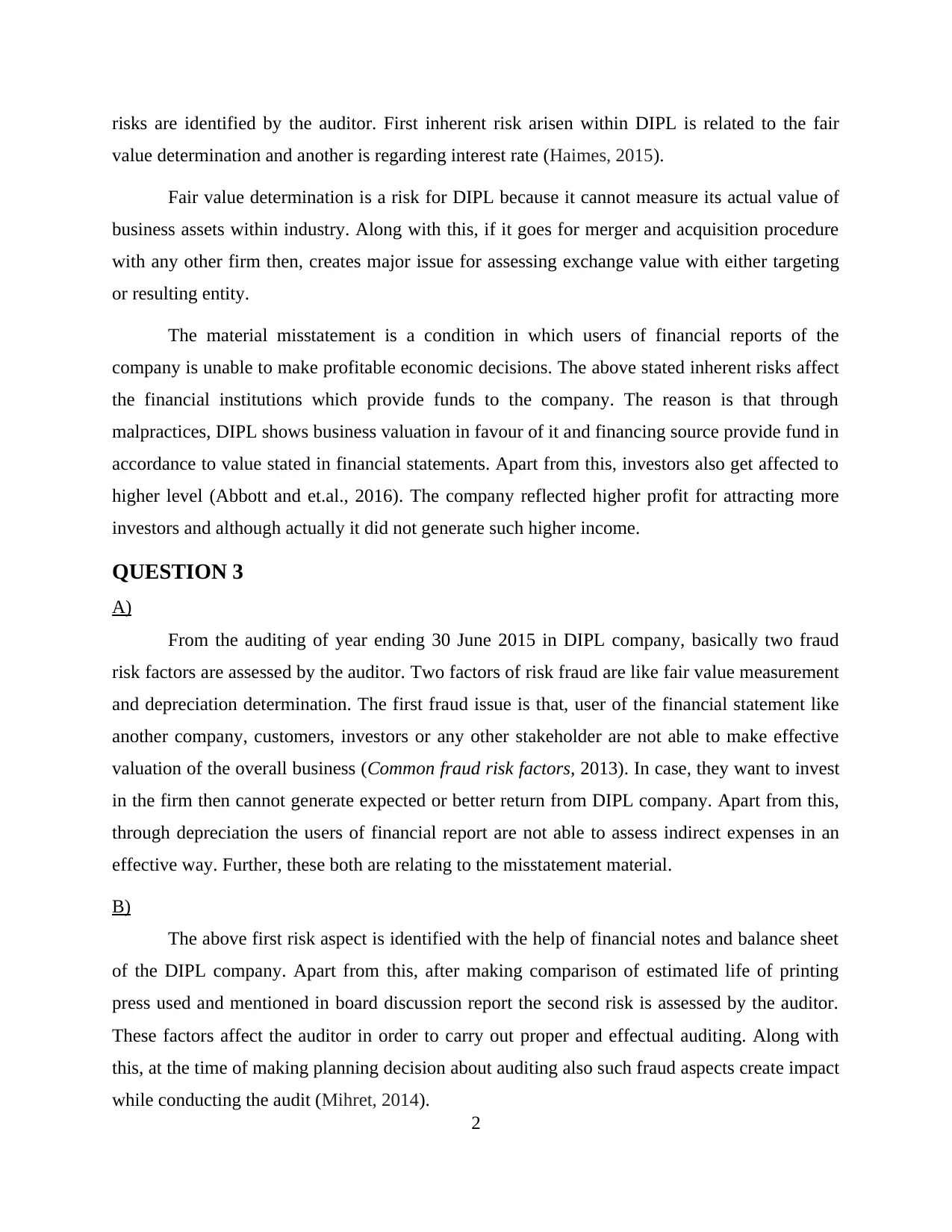
risks are identified by the auditor. First inherent risk arisen within DIPL is related to the fair
value determination and another is regarding interest rate (Haimes, 2015).
Fair value determination is a risk for DIPL because it cannot measure its actual value of
business assets within industry. Along with this, if it goes for merger and acquisition procedure
with any other firm then, creates major issue for assessing exchange value with either targeting
or resulting entity.
The material misstatement is a condition in which users of financial reports of the
company is unable to make profitable economic decisions. The above stated inherent risks affect
the financial institutions which provide funds to the company. The reason is that through
malpractices, DIPL shows business valuation in favour of it and financing source provide fund in
accordance to value stated in financial statements. Apart from this, investors also get affected to
higher level (Abbott and et.al., 2016). The company reflected higher profit for attracting more
investors and although actually it did not generate such higher income.
QUESTION 3
A)
From the auditing of year ending 30 June 2015 in DIPL company, basically two fraud
risk factors are assessed by the auditor. Two factors of risk fraud are like fair value measurement
and depreciation determination. The first fraud issue is that, user of the financial statement like
another company, customers, investors or any other stakeholder are not able to make effective
valuation of the overall business (Common fraud risk factors, 2013). In case, they want to invest
in the firm then cannot generate expected or better return from DIPL company. Apart from this,
through depreciation the users of financial report are not able to assess indirect expenses in an
effective way. Further, these both are relating to the misstatement material.
B)
The above first risk aspect is identified with the help of financial notes and balance sheet
of the DIPL company. Apart from this, after making comparison of estimated life of printing
press used and mentioned in board discussion report the second risk is assessed by the auditor.
These factors affect the auditor in order to carry out proper and effectual auditing. Along with
this, at the time of making planning decision about auditing also such fraud aspects create impact
while conducting the audit (Mihret, 2014).
2
value determination and another is regarding interest rate (Haimes, 2015).
Fair value determination is a risk for DIPL because it cannot measure its actual value of
business assets within industry. Along with this, if it goes for merger and acquisition procedure
with any other firm then, creates major issue for assessing exchange value with either targeting
or resulting entity.
The material misstatement is a condition in which users of financial reports of the
company is unable to make profitable economic decisions. The above stated inherent risks affect
the financial institutions which provide funds to the company. The reason is that through
malpractices, DIPL shows business valuation in favour of it and financing source provide fund in
accordance to value stated in financial statements. Apart from this, investors also get affected to
higher level (Abbott and et.al., 2016). The company reflected higher profit for attracting more
investors and although actually it did not generate such higher income.
QUESTION 3
A)
From the auditing of year ending 30 June 2015 in DIPL company, basically two fraud
risk factors are assessed by the auditor. Two factors of risk fraud are like fair value measurement
and depreciation determination. The first fraud issue is that, user of the financial statement like
another company, customers, investors or any other stakeholder are not able to make effective
valuation of the overall business (Common fraud risk factors, 2013). In case, they want to invest
in the firm then cannot generate expected or better return from DIPL company. Apart from this,
through depreciation the users of financial report are not able to assess indirect expenses in an
effective way. Further, these both are relating to the misstatement material.
B)
The above first risk aspect is identified with the help of financial notes and balance sheet
of the DIPL company. Apart from this, after making comparison of estimated life of printing
press used and mentioned in board discussion report the second risk is assessed by the auditor.
These factors affect the auditor in order to carry out proper and effectual auditing. Along with
this, at the time of making planning decision about auditing also such fraud aspects create impact
while conducting the audit (Mihret, 2014).
2
Paraphrase This Document
Need a fresh take? Get an instant paraphrase of this document with our AI Paraphraser
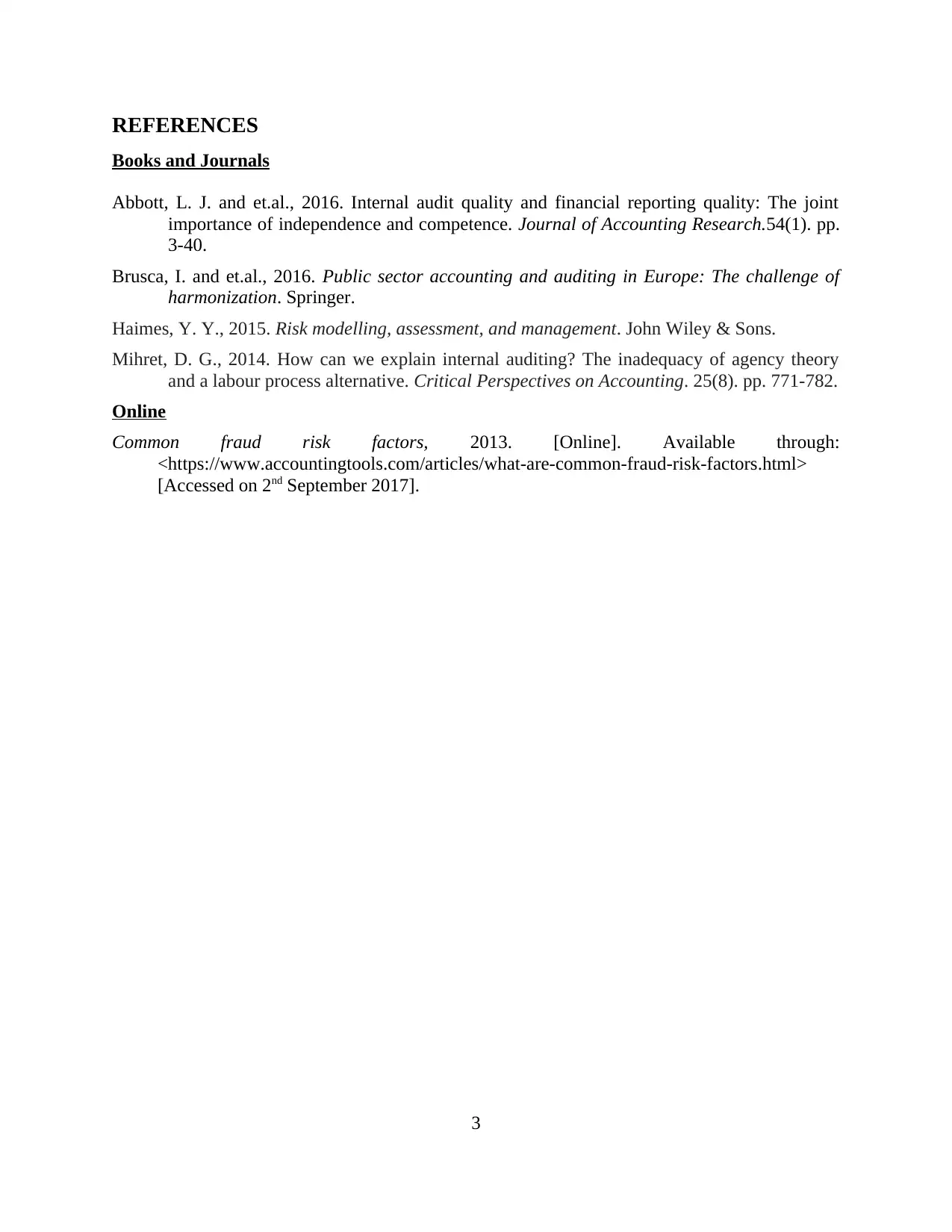
REFERENCES
Books and Journals
Abbott, L. J. and et.al., 2016. Internal audit quality and financial reporting quality: The joint
importance of independence and competence. Journal of Accounting Research.54(1). pp.
3-40.
Brusca, I. and et.al., 2016. Public sector accounting and auditing in Europe: The challenge of
harmonization. Springer.
Haimes, Y. Y., 2015. Risk modelling, assessment, and management. John Wiley & Sons.
Mihret, D. G., 2014. How can we explain internal auditing? The inadequacy of agency theory
and a labour process alternative. Critical Perspectives on Accounting. 25(8). pp. 771-782.
Online
Common fraud risk factors, 2013. [Online]. Available through:
<https://www.accountingtools.com/articles/what-are-common-fraud-risk-factors.html>
[Accessed on 2nd September 2017].
3
Books and Journals
Abbott, L. J. and et.al., 2016. Internal audit quality and financial reporting quality: The joint
importance of independence and competence. Journal of Accounting Research.54(1). pp.
3-40.
Brusca, I. and et.al., 2016. Public sector accounting and auditing in Europe: The challenge of
harmonization. Springer.
Haimes, Y. Y., 2015. Risk modelling, assessment, and management. John Wiley & Sons.
Mihret, D. G., 2014. How can we explain internal auditing? The inadequacy of agency theory
and a labour process alternative. Critical Perspectives on Accounting. 25(8). pp. 771-782.
Online
Common fraud risk factors, 2013. [Online]. Available through:
<https://www.accountingtools.com/articles/what-are-common-fraud-risk-factors.html>
[Accessed on 2nd September 2017].
3
1 out of 5
Related Documents
Your All-in-One AI-Powered Toolkit for Academic Success.
+13062052269
info@desklib.com
Available 24*7 on WhatsApp / Email
![[object Object]](/_next/static/media/star-bottom.7253800d.svg)
Unlock your academic potential
Copyright © 2020–2025 A2Z Services. All Rights Reserved. Developed and managed by ZUCOL.





